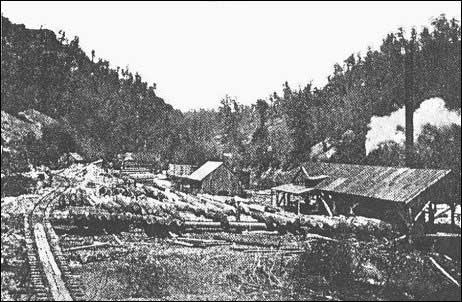Elevation Of Logs Into The Mill
Provided the head saw was on the same level as the storage area, the logs could be rolled directly onto the log deck. If a pond was used, there needed to be a way to transport the logs to the log deck.
The simplest method used in the early and small mills, consisted of a planked incline leading from the waters edge to the log deck. A winch, located on the deck, used a rope or wire cable with an attached hook. The end of the cable was dragged out to the pond by hand, the hook hammered into the log, and the winch hauled the logs onto the deck. This method required much hard labor and time.
The most frequently encountered device was the log-jacker or jack-slip. This was a “V” shaped trough, leading from below the pond surface to the log deck. It could either be of wood or metal construction and was supported by trestle-work. There was a walkway along at least one side for the workmen. A log-washing device could be incorporated into the jack-slip, and a continuous chain with pointed hooks or dogs, ran within the trough and across the log deck. The lower chain wheel was under water. As the log reached the limit of the log deck, the chain entered a depression in the floor and allowed the dogs to release the log.
Occasional use has been made of a water channel, parallel with the log deck. Cables were lowered and passed under the log. Then the cable was raised, bringing the log up to the level of log deck. Aerial cables have also been used and infrequently, the entire loaded log car was winched to the level of the log deck and unloaded. The East Waterford Lumber Company mill in Juniata County, Pennsylvania, is known to have used this method.

Circular Saw Mill With Log Roll-Way
(Red River Museum & Historical Society)
